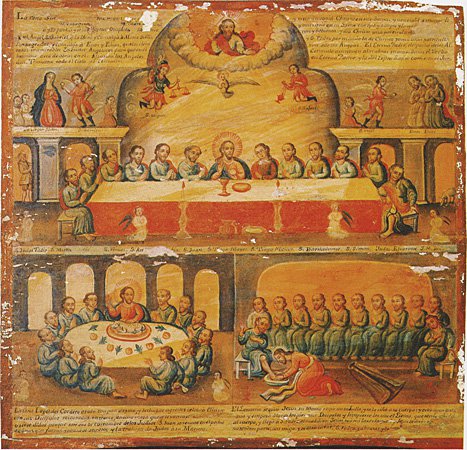Cultural Center of the Philippines
ENCYCLOPEDIA OF
PHILIPPINE ART
[Olivar Pasion Altarpiece]
Ca 1750 / Oil on panel / 40.6 x 40.6 cm / Artist: J.M. Olivar / Private collection
The pasion altarpiece was displayed in the family altar before which folk gathered to chant the pasion or Christ’s life and passion from handwritten or printed books during Lent. In the early 1700s this genre grew in popularity. Its composition follows certain conventions—in particular, the painting is sectionalized into three parts depicting the Institution of the Holy Eucharist, the Feast of the Passover, and the Washing of the Feet. It is replete with inscriptions.
In the Olivar altarpiece, named after the signature in the piece (probably the painter), the composition is divided horizontally into two planes. The Institution of the Holy Eucharist occupies the upper half, following the renaissance Last Supper conventions showing Christ flanked by the apostles, six on each side. Olivar jotted down the names of the holy personages under their figures. Apparently he painted himself in the person of a genuflected angel on the lower right corner of the scene, under which he inscribed his signature, J.M. Olivar.
The pasion altarpiece was inspired by apocryphal narratives. Above the Last Supper, flanking a heavenly spectacle showing God the Father, the Holy Spirit, Mary, and the saints, are inscriptions that narrate the story of San Gabriel administering the Holy Communion to the Virgin and San Pedro giving the sacrament to Old Testament personalities Enoc and Elias “whom the angels carried to heaven.” Enoc and Elias, however, are shown being administered by an angel with his name, Ariel, inscribed under him.
The lower half of this work is divided into the Passover and the Washing of the Feet. Writings below the scene state that the Passover feast consisted of cordero asado or roast veal, pan azymo or unleavened bread, and lechugas agrestes or wild lettuce. The Washing of the Feet is similarly preoccupied with earthly particulars that fascinated the faithful. The inscriptions state that Christ removed his cape (which lies stiffly on the floor), took the “holy towel” and tied it around his waist, poured water on a basin, approached each of the apostles and proceeded to wash their feet (except for Simon Peter who initially refused to be washed).
The Olivar altarpiece is definitely of 18th-century vintage. Small and fine details, like parts of limbs and facial features, were apparently rendered with a sharp brush if not a quill. A rhythmic but rigid arrangement of figures and objects was a result of a conscious desire to follow the conventions of painting, then at an early stage of development. The restricted palette, consisting of only three colors—blue, red, and ocher—and their wash-like manner of application although they are oil based, also point to an 18th-century provenance.
Written by Santiago A. Pilar
